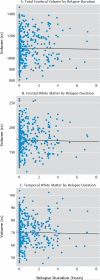Relapse duration, treatment intensity, and brain tissue loss in schizophrenia: a prospective longitudinal MRI study
- PMID: 23558429
- PMCID: PMC3835590
- DOI: 10.1176/appi.ajp.2013.12050674
Relapse duration, treatment intensity, and brain tissue loss in schizophrenia: a prospective longitudinal MRI study
Erratum in
- Am J Psychiatry. 2013 Jun 1;170(6):689
Abstract
Objective: Longitudinal structural MRI studies have shown that patients with schizophrenia have progressive brain tissue loss after onset. Recurrent relapses are believed to play a role in this loss, but the relationship between relapse and structural MRI measures has not been rigorously assessed. The authors analyzed longitudinal data to examine this question.
Methods: The authors studied data from 202 patients drawn from the Iowa Longitudinal Study of first-episode schizophrenia for whom adequate structural MRI data were available (N=659 scans) from scans obtained at regular intervals over an average of 7 years. Because clinical follow-up data were obtained at 6-month intervals, the authors were able to compute measures of relapse number and duration and relate them to structural MRI measures. Because higher treatment intensity has been associated with smaller brain tissue volumes, the authors also examined this countereffect in terms of dose-years.
Results: Relapse duration was related to significant decreases in both general (e.g., total cerebral volume) and regional (e.g., frontal) brain measures. Number of relapses was unrelated to brain measures. Significant effects were also observed for treatment intensity.
Conclusions: Extended periods of relapse may have a negative effect on brain integrity in schizophrenia, suggesting the importance of implementing proactive measures that may prevent relapse and improve treatment adherence. By examining the relative balance of effects, that is, relapse duration versus antipsychotic treatment intensity, this study sheds light on a troublesome dilemma that clinicians face. Relapse prevention is important, but it should be sustained using the lowest possible medication dosages that will control symptoms.
Figures


Comment in
-
The long-term effect of schizophrenia on the brain: dementia praecox?Am J Psychiatry. 2013 Jun;170(6):571-3. doi: 10.1176/appi.ajp.2013.13030413. Am J Psychiatry. 2013. PMID: 23732960 No abstract available.
References
-
- Murray CJL, Lopez AD, Global Burden of Disease . A Comprehensive Assessment of Mortality and Disability From Diseases, Injuries, and Risk Factors in 1990 and Projected to 2020. Harvard University Press; Cambridge, Mass: 1996.
-
- Nopoulos P, Torres I, Flaum M, Andreasen NC, Ehrhardt JC, Yuh WTC. Brain morphology in first-episode schizophrenia. Am J Psychiatry. 1995;152:1721–1723. - PubMed
-
- Ho BC, Andreasen NC, Nopoulos P, Arndt S, Magnotta V, Flaum M. Progressive structural brain abnormalities and their relationship to clinical outcome: a longitudinal magnetic resonance imaging study early in schizophrenia. Arch Gen Psychiatry. 2003;60:585–594. - PubMed
-
- Lim KO, Tew W, Kushner M, Chow K, Matsumoto B, DeLisi LE. Cortical gray matter volume deficit in patients with first-episode schizophrenia. Am J Psychiatry. 1996;153:1548–1553. - PubMed
MeSH terms
Substances
Grants and funding
LinkOut - more resources
Full Text Sources
Other Literature Sources
Medical

